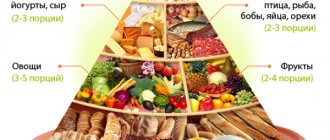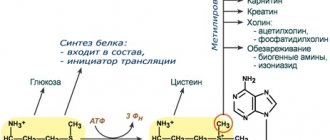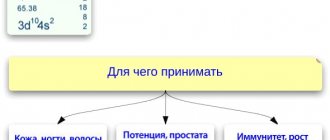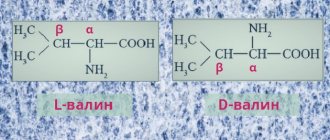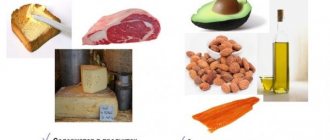- September 25, 2018
- Seasonings
- Olga Ivanovna
At the end of the 19th century, active study of amino acids began. L-cysteine was discovered by O. Bauman. Despite the fact that he described the mechanism of formation of this amino acid back in 1884, its exact formula was established almost 20 years later by the scientist Erlenmeyer. Significant merit in the study of amino acids belongs to the scientist Merner, who managed to extract this substance from the tissues of cattle horns.
Cysteine: amino acid
Cysteine is part of the group of sulfur-containing aliphatic amino acids. Composed of proteins and peptides, it influences the formation of healthy tissues of hair, skin and nails. Being a non-essential amino acid, it is a completely self-sufficient nutritional element. And it can be synthesized by the body in the full amount necessary to maintain hair and skin in normal condition.
Under conditions of constant or short-term stress, intense physical activity and illness, the production of cysteine in the body decreases.
And there is a need for additional supply of amino acids from the outside.
Contraindications and side effects
The use of L-cysteine capsules should be discussed with your doctor. Absolute contraindications are diabetes mellitus and cystinuria, a rare genetic disease in which there is a tendency to form cystine stones in internal organs.
A relative contraindication is pregnancy and breastfeeding. Any medications at this time must be used strictly according to indications, monitoring the patient’s condition. You should also definitely consult a doctor if you have already diagnosed kidney and liver problems. Possible negative consequences may include individual intolerance to the drug, as well as digestive disorders associated with insufficient absorption of sulfur-containing amino acids.
Reviews of L-cysteine
Reviews of drugs containing L-cysteine online are generally positive. In reviews, people write that cysteine helps in the fight against aging, lack of collagen, and poor condition of skin, hair, and nails. Athletes also note the help of L-cysteine in daily training. Cysteine supplements help cope with stress and increase muscle mass. If you have taken capsules with this drug, you can leave your review in the comments to the article.
Victoria:
After the birth of my child, my skin and hair condition worsened. I started taking L-cysteine capsules, and the results appeared almost immediately. Among the “side effects” is that excess weight is lost faster, which this remedy also helps eliminate. Now I’m taking a break, in a month I’ll start taking capsules again, I liked the result.
Igor:
I started taking this supplement at the insistence of my wife. I actively train, cysteine also helps the growth of muscle mass, but at the same time it does not have many side effects of other drugs. The drug really works, it makes it easier to endure intense exercise without harm to health.
Olga:
At the beginning of the winter season, she suffered from several colds in a row, and for a long time after that she restored her immunity. I was advised to take L-cysteine capsules together with vitamin C. The product helped me recover faster, my well-being and even my mood improved significantly.
L-cysteine is part of the well-known mucolytic drug NAC, whose unique properties were discovered in the 50s of the last century. We will talk about the benefits and effects of NAC in our next article.
Most Popular L-Cysteine Supplements
Now Foods, L-cysteine, 500 mg, 100 tablets - iHerb Reviews: 2905 Price: $9.12 Economy shipping!!!
Solgar, L-Cysteine, 500 mg, 90 Veggie Capsules - iHerb Reviews: 104 Price: $19.12 Economy Shipping!!!
California Gold Nutrition, AjiPure, L-Cysteine, 500 mg, 60 Veggie Capsules - iHerb Reviews: 75 Price: $10 Economy Shipping!!!
Source Naturals, L-Cysteine, 3.53 oz (100 g) - iHerb Reviews: 35 Price: $18.89 Economy Shipping!!!
Bluebonnet Nutrition, L-Cysteine, 500 mg, 60 Veggie Capsules - iHerb 25 Reviews Price: $17.56 Economy Shipping!!!
Cysteine in food
Cysteine in food is contained in sufficient quantities for the body, provided proper nutrition. This becomes possible due to the self-healing property of the substance.
The amino acid is found in foods high in protein. This undoubtedly includes meat and eggs, as well as milk and fermented milk products. There is enough cysteine in plant foods, such as legumes and nuts.
Some foods rich in cysteine (per 100 grams):
- soy – 655 mg,
- sunflower seeds – 451 mg,
- whole peas (peeled) – 373 mg,
- chicken egg – 272 mg,
- pork – 242 m,
- chicken fillet – 222 mg,
- salmon – 220 mg,
- walnuts – 208 mg,
- unshelled rice – 96 mg,
- raw milk – 30 mg.
We should not forget that any heat treatment of food leads either to a decrease in the amino acid content or to its complete breakdown. Which reduces the value of all the above products.
The amino acid is especially well absorbed in capsule form.
Possibility of overdose
An excess of the substance in the body is most often observed when the instructions for the drugs are not followed and the therapeutic dose is significantly exceeded. Symptoms of overdose can also occur during treatment with dietary supplements and the constant presence in the diet of foods high in cysteine (eggs, bran bread, cereals).
Signs of excess amino acid in the body:
- nausea and vomiting;
- diarrhea;
- stomach ache;
- breathing problems;
- arrhythmia;
- severe headaches.
If such symptoms appear, you should stop using the medication and seek medical help. The doctor will determine the severity of the condition and, if necessary, conduct detoxification therapy. In most cases, an overdose occurs without long-term consequences.
Cysteine: properties
The main properties of cysteine in the body are the synthesis of several active substances that are responsible for the normal functioning of metabolic processes and the immune system. Cysteine is broken down in the body into two isomers D and L. The L isomer of this amino acid plays an important role in the production of collagen, which ensures the vital functions of human hair and skin. These substances are actively used in cosmetology along with hyaluronic acid. By supplying epithelial cells, they make the skin firm and elastic. Reduces the aging process in the body. The role of the L cysteine in the processes of digestion and metabolism is very important, since it is responsible for the optimal absorption and distribution of nutrients from the blood and food. Cysteine is the main supplier and at the same time a catalyst in the synthesis reactions of keratin, taurine, methionine, coenzyme A and glutathione tripeptide.
Keratin, derived from cysteine , forms the protein basis of skin, hair and nails and is the main building material for them.
Taurine plays a key role in normalizing the functioning of the uneven system and resisting stress. This substance also takes an active part in burning fat cells and building muscle mass, and regulates blood pressure.
Properties of glutathione tripeptide:
- provides immune resistance to external environmental factors;
- has pronounced antioxidant properties;
- slows down the aging process.
Coenzyme A takes an active part in the production of vitamin B5, which is responsible for important processes in the body:
- Strengthening the immune system and reducing inflammatory processes in the body;
- Protecting the nervous system from harmful compounds
- Reduces side effects from taking medications, restoring cellular structure;
- Helps reduce excess weight by participating in lipid metabolism.
Why does the body need this amino acid?
The role of L-cysteine in human life is difficult to overestimate. Here are just a few of the “merits” of this amino acid to the body:
- Takes part in the process of lymphocyte production.
- Increases the thickness of the hair shaft, treats alopecia.
- Takes part in the production of glucose, providing the body with vital energy.
- Protects mucous membranes from destruction and stimulates their regeneration process.
- Reduces the risk of heart attacks and strokes by strengthening the walls of blood vessels and giving them elasticity.
- Burns excess subcutaneous fat.
- Stimulates the growth and regeneration of muscle tissue.
- Stimulates collagen synthesis, which helps maintain youthful skin and vascular mobility.
- Normalizes metabolic processes.
- Removes all harmful substances from the body, including heavy metals.
- Suppresses inflammatory processes.
- Increases physical endurance and mental performance.
- Increases bone density and strength, preventing the development of osteoporosis.
Cysteine: application
The amino acid is widely used in areas such as sports nutrition and medicine. Cysteine , like alpha-lipoic acid, is successfully used in cosmetic procedures.
Cysteine , use in sports:
- a powerful natural antioxidant that promotes rapid recovery after heavy exercise;
- accelerates muscle growth in athletes;
- ensures the synthesis of glutathione and a decrease in catabolic processes in the body;
- improves digestive functions.
In medicine, cysteine is used to treat cataracts in the initial stages and diseases associated with a lack of vitamins in the body. It is actively used in rehabilitation therapy for accelerated healing of injuries and postoperative rehabilitation. Helps thin and remove mucus (we all know the famous drug ACC, it contains a more complex form of cysteine N acetyl cysteine).
Application in the food industry
In the composition of some products and products you can see the E920 additive - this is the amino acid in question. In the international classification it belongs to the category of permitted. In particular, this additive is used in bread production. It significantly improves the properties of the dough (giving elasticity) and the finished product (reducing the likelihood of cracks and voids). Also, under the influence of cysteine, the time for rising dough is reduced and the amount of the final product increases.
The substance is actively used in the production of meat products in combination with dyes. The amino acid significantly speeds up the process of coloring the product, and also ensures color preservation during storage and heat treatment. In addition to these properties, E920 significantly enhances the taste properties of sausages.
Cysteine: for hair
The amino acid has strong properties for cell restoration, this explains the positive effect of the drug cysteine for hair. The main component of hair is keratin. The amino acid cysteine takes an active part in the synthesis of this protein, reviving the natural structure of the hair. Doctors often recommend taking additional biotin with cysteine.
Beneficial effects of cysteine on hair:
- Hair becomes much stronger and begins to grow faster;
- Restores the structure of damaged hair after curling and other chemical influences;
- Thanks to its fat-burning properties, it reduces the lipid content in the hair and scalp;
- Blocks the action of free radicals, normalizing the structure of dry hair;
- Maintains normal acid-base balance;
- Has a pronounced conditioning effect.
What is L cysteine and its synthesis in the body and in industry
As mentioned, L-cysteine is a non-essential amino acid. It is necessary for the formation of essential substances in the body, such as:
- Glutathione. A strong antioxidant that is important for the good functioning of the immune and nervous systems.
- Taurine. Indispensable for the functioning of the central nervous system, improves metabolism, burns excess fat and promotes muscle growth. Also protects eye health and normalizes blood pressure.
It has been confirmed that it is impossible to maintain the required level of glutathione in the body without consuming L cysteine.
This amino acid is actively involved in the production of lymphocytes in the blood. In the human body, L-cysteine is synthesized from methionine, another sulfur-containing amino acid. In order for the process of converting methionine to cysteine to proceed correctly, additional elements must be involved. Among them are vitamins B6 and E, serine compounds and hydrogen sulfide.
A deficiency of any of the necessary components causes a “system failure.” Therefore, an insufficient amount of synthesized L-cysteine indicates a lack of essential microelements and vitamins, as well as problems with metabolism and liver function.
In industry, L-cysteine is produced in two forms - synthetic and natural. A natural product is easier and cheaper to produce; it is obtained from animal hair, bird feathers and human hair. The process of creating a synthetic substance is more complex and more expensive. But an amino acid of any form is recognized as a high-quality food product and a safe product.
Cysteine: for eyes
The presence of cysteine , a sulfhydryl group, in the molecule ensures the rapid occurrence of chemical metabolic reactions in the tissues of the eyeball. By actively accelerating metabolic processes, cysteine has a healing effect on the eyes, increasing the transparency of the lens and thereby improving visual acuity. The drug is often prescribed to prevent clouding of the lens (cataract) in the initial stages of the disease. We also recommend looking at supplements containing lutein and zeaxanthin.
Effect on the human body
Cysteine is used not only in the treatment of diseases, but also to maintain general human health. At the same time, it affects the body of men and women differently. Let's discuss this in more detail.
Impact on men's health
Taking supplements containing N-acetylcysteine increases sperm motility, which helps improve male fertility. The use of L-cysteine together with selenium increases the viscosity of seminal fluid, which facilitates easier fertilization of the egg and pregnancy of the partner. In some cases, we can even talk about a complete cure of certain types of infertility in men.
The use of cysteine can also solve problems with potency. The amino acid affects the erectile function of men by participating in the production of nitric oxide. Nitric oxide has a relaxing effect on the walls of blood vessels, which helps a man develop a persistent erection.
Should women take it?
Eating supplements containing L-cysteine will not be superfluous for women either. In addition to its use in medicine, the amino acid is actively used in cosmetology. It will improve the condition and appearance of skin, nails and hair. Cysteine breakdown products help slow down the aging process and prolong the youth of the female body.
Cysteine: hydrochloride
Cysteine hydrochloride is a white powder. Without a pronounced odor. A rapidly soluble compound often used in medicine to treat various diseases. Cysteine hydrochloride is prescribed for arterial disorders, rheumatoid arthritis and cancer. Increases the speed of recovery of the body after operations and burns. Removes heavy metal salts. Has a fat burning effect.
In the register of food additives, the substance is registered under the code E 920.
Biological role
The nonessential amino acid compound cysteine is synthesized in the body with the participation of methionine, serine, and pyridoxine (vitamin B6). The formation of a sulfur-containing amino acid requires the presence of hydrogen sulfide. Normally, nutrient synthesis completely covers the needs of an adult. In case of liver diseases, metabolic disorders, active physical activity, the amount of the substance decreases.
Under the influence of cysteine, 2 important compounds are synthesized:
- Glutathione. It is a powerful natural antioxidant, protects cells from free radicals, and slows down the aging process. The substance is necessary for the proper functioning of cellular immunity.
- Taurine. Helps with the functioning of the cardiovascular, nervous and endocrine systems. Supports visual function and participates in metabolic reactions.
L-cysteine also produces a number of beneficial effects:
- improves muscle tone and strength, elasticity of the vascular wall, as well as the condition of the skin, nails, and hair structure;
- reduces the risk of cardiovascular crises, the activity of inflammatory processes;
- promotes muscle growth, detoxification of the body from heavy metal salts and other harmful substances;
- increases endurance and energy, as well as blood supply and trophism of the eye lens;
- participates in the synthesis of building proteins, collagen and elastin;
- activates metabolic processes, helps burn excess fat;
- normalizes immune reactions.
Now Foods, L-Cysteine, 500 mg, 100 Tablets
★★★★☆
from 728 ₽
More details
Cysteine: dipeptide
Cysteine dipeptide is a molecule formed by two amino acids. It is a peptide bond between an aliphatic sulfur-containing acid ( cysteine ) and the carboxyl group of another amino acid compound.
Possessing free amino acid compounds and carboxyl groups at different ends, the dipeptide can create groups of several amino acids of different composition. As a result of this reaction, a complex rich in amino acids is formed, which helps to better absorb other organic compounds, tissue and hair cells.
Compatibility with other drugs and substances
Today, science has made great progress in the study of cysteine. Its effect on the body in case of long-term use is considered. The compatibility of AK with other substances raises some concerns.
Dietary supplements containing cysteine can interact with medications. For example, inhibit the work of drugs for the treatment of sore throat, inhibitors, enzymes. Particular care is required when taking amino acids and immunosuppressants (Prednisolone, etc.) in parallel. AK is not recommended for nursing and expectant mothers.
In order to obtain maximum benefit, a complex intake of cysteine and vitamins, and B6 (pyridoxine) is recommended. Also calcium (Ca), sulfur (S) and selenium (Se), which greatly enhances the effectiveness of AK.
Cysteine: exchange
The drug cysteine takes an active part in human metabolism, as it is the main supplier of sulfur in the body tissue.
The amino acid is obtained from the synthesis of serine by replacing the hydroxyl group of sulfur from the compound with the amino acid. Next, cysteine forms a catalytic center with the protease and reacts with sulfides, forming two sulfide bonds.
With the help of these bonds, the structure of proteins is formed at the tertiary and quaternary levels.
Cysteine is also actively involved in the creation of glutathione tripeptide molecules.
Glutathione molecules prevent ferrous iron from binding to oxygen in blood cells.
How quickly does the effect of taking cysteine appear?
L-cysteine is an easily absorbed amino acid by the body. It is easily absorbed by the stomach when taken orally, after which cysteine biochemically breaks down into various derivatives: taurine, glutathione, chondroitinsulfuric acid and some other substances. For these processes to occur, cysteine is oxidized in the body. The benefits of taking the amino acid have been clinically proven, and the effect begins immediately after it enters the stomach. The appearance of the effect of the intake is accelerated by additional consumption of selenium and vitamin C.
Cysteine: Solgar
cysteine preparation “L-Cysteine” from the famous company Solgar is an essential amino acid for healthy nails, skin and hair. Participates in the production of keratin, methionine, taurine and glutathione.
Delivery form: dark-colored glass bottles. Number of capsules - 90 pcs.
Release form: yellow capsules.
Features of the drug:
- does not contain lactose, gluten and wheat starch;
- can be consumed by vegetarians;
- high quality products;
- dietary supplement.
Compound:
- cysteine 500 mg;
- vegetable cellulose.
Recommendations for use: adults are recommended to take 1 capsule 1-3 times a day as a dietary supplement after meals. It is advisable to use the drug between meals.
What's the best way to take it?
Cysteine is contained in preparations in various forms: L-cysteine, N-acetylcysteine, cysteine hydrochloride, cysteine dipeptide, acestine. The use of one form or another of this substance depends on the purpose of the drug. Cysteine is also found in food products in the form of a registered additive E920, but this additive, although absolutely harmless, does not have any beneficial properties for the body. In addition, the amino acid is destroyed when heated, so using the supplement in this form becomes absolutely useless.
You can find various forms of cysteine on iHerb. These may be tablets, capsules or powders to be taken orally, or a liquid form such as eye drops. The effectiveness of the drug does not depend in any way on the form of use; their diversity is due only to ease of use.
It is recommended to use cysteine simultaneously with taking vitamin C. When taking the amino acid, it is necessary to increase the usual daily water intake for better absorption of the drug.
Nutricology, NAC N-Acetyl-L-Cysteine, 120 Tablets
See price on iHerb
Cysteine: in pharmacies
Buying a drug containing cysteine in pharmacies can result in, at a minimum, wasted funds. More serious consequences are also possible, since pharmacies often sell products with a low content of the active substance or of low quality. According to customer reviews, counterfeit drugs are often found in public pharmacies. Insufficient dosage and, as a result, lack of effect is only a small price that a consumer who has chosen this method of purchasing cysteine . Therefore, many Russians and others purchase cysteine in the USA in a specialized online store (link below).
Summarize
In the human body, there is a continuous exchange of cysteine, consisting of the process of its synthesis and subsequent breakdown. Despite this, sometimes it is necessary to provide additional intake of L-cysteine.
If symptoms such as deterioration of skin and hair, digestive disorders, or deterioration of brain function occur, it may be useful to buy a drug containing cysteine. Taking medications containing this amino acid will help avoid many serious diseases and prolong the youth of the body.
Cysteine: instructions
To maintain vigor and health, the amino acid must be taken every day. The daily intake of cysteine , according to the instructions, is set at 500 mg per day. If necessary, the dose can be increased to 1500 mg.
Cysteine: how to take
It is strictly not recommended to take more than 7 g of cysteine as a daily dose. Take 1 capsule of 500 mg 1-3 times a day. Only athletes can take higher dosages up to 3000 mg with caution.
To prevent the formation of kidney stones, it is recommended to take 1500 mg of vitamin C cysteine
Dosage
Having studied the instructions for the use of L-cysteine in various drugs, we can note some discrepancies in the daily intake rate. This is directly related to the purpose of the product. Naturally, for example, to combat baldness and strengthen the immune system, different dosages of the amino acid are required.
In most cases, 500-1500 mg of the substance per day is sufficient to maintain normal functioning of the body. A more significant amount is applicable only as prescribed by a doctor. The critical dose after which an overdose occurs is 7 g of pure amino acid per day.
Cysteine: reviews
Cysteine received only a positive rating in the reviews of numerous buyers posted on sales websites of the original drug. People who have tried the drug write that it really helps restore skin elasticity and improve vision. Shortens the rehabilitation period after various injuries. Many customers note that cysteine really makes scalp hair and eyebrows thick and silky. It really burns fat a little and reduces weight (stronger effect from fat burners and L-carnitine).
How is cysteine different from L-cysteine?
You can often see the inscription L-cysteine on medicine packages. How does it differ from “regular” cysteine? The fact is that cysteine is the general name of a chemical substance that can take the form of two isomers: L-cysteine and D-cysteine. Living organisms contain only L-isomers of amino acids, which is why L-cysteine is used for oral administration.
Cysteine: price
buy cysteine of the required concentration only on the Internet, using the link given at the end of the page. Cysteine , the price of which on the Internet is 2-5 times lower, allows the buyer to save money and receive a product of proper quality. The low cost of the drug, the best guarantee of quality, since supplies are carried out directly from the manufacturer, and the absence of many intermediaries, allows you to sell products without increasing the cost.
On the pharmacy's website, you can also purchase other rare remedies and supplements to improve your health, for example, royal jelly, castor oil, cordyceps or rare pycnogenol.
Cysteine is a conditionally nonessential aliphatic α-amino acid.
Cysteine is a sulfur-containing amino acid, since its synthesis requires a sulfur atom, the source of which is the essential amino acid methionine.
Also, for the synthesis of cysteine in the body, another amino acid is needed - serine (a source of the carbon skeleton), as well as ATP and vitamin B6.
Cysteine is 2-amino-3-mercaptopropanoic acid or α-amino-β-thiopropionic acid.
Cysteine ( Cys, Cys , C ) has the chemical formula HO2CCH (NH2) CH2SH.
Cysteine was first isolated as cystine by K. Merner in 1899 from horn.
The daily requirement for cysteine is 2-3 grams.
Physical properties
Cysteine is colorless crystals, easily soluble in water. Melting point 1780C.
Pathways of cysteine metabolism
Cysteine is an extremely important amino acid due to the fact that it is the only source of organic sulfur for the body's cells. As a result of metabolic reactions, this sulfur is converted into other sulfur-containing substances - phosphoadenosine phosphosulfuric acid (FAPS), coenzyme A, glutathione, and sulfonated carbohydrate derivatives.
Biological role
Cysteine can be found in proteins in two forms: either in the form of cysteine or in the form of a dipeptide - cystine, which is a complex of two cysteine molecules covalently linked to each other using a disulfide bridge.
Thanks to this property, cysteine performs an important function in stabilizing the structure of the protein molecule.
Cysteine plays a key role in the formation of insulin and immunoglobulins (antibodies).
Cysteine is part of proteins and peptides and plays an important role in the formation of skin tissue.
Cysteine has antioxidant properties.
Participates in the process of biological detoxification in case of poisoning with toxic substances (decomposes and removes toxins from the body).
Cysteine is involved in the biosynthesis of cystine, glutathione, taurine and coenzyme A.
Cysteine is a precursor to glutathione, a substance that protects liver and brain cells from damage by alcohol, certain medications, and toxic substances contained in cigarette smoke.
Cysteine is part of alpha keratin, the main protein of nails, skin and hair. It promotes collagen formation and improves skin elasticity and texture.
Cysteine promotes digestion by participating in transamination processes.
Proteins containing cysteine, such as metallothionein, are able to bind metals such as mercury, lead and cadmium.
Cysteine is involved in the synthesis of taurine in animal tissues. Taurine is necessary for the synthesis of paired bile acids in the liver. In addition, it is very important in cells as an antioxidant.
Cysteine is involved in the metabolism of the eye lens. The changes that occur with cataracts are associated with a violation of the content of this amino acid in the lens.
A characteristic feature of cysteine is its ability to undergo spontaneous oxidation within a protein molecule to form cystine residues.
Although cysteine is classified as a nonessential amino acid, in rare cases it may be vital for infants, the elderly, and those with a disease that occurs due to disruption of the digestive transport function of the small intestine, leading to metabolic disorders.
Under normal physiological conditions, with sufficient amounts of available methionine, cysteine can be synthesized in the human body. Cysteine is catabolized in the gastrointestinal tract and blood plasma.
Natural springs
Cysteine is found in most high protein foods.
Animal sources: meat (pork, chicken, turkey, duck), eggs, milk, whey protein, ricotta, cottage cheese, yogurt.
Plant sources: red pepper, garlic, onion, broccoli, Brussels sprouts, oats, muesli, wheat germ, sprouted lentils, peas, soy, rice.
Areas of use
Cysteine is a starting material in the food, pharmaceutical and medical industries.
Cysteine is often used to create odors. For example, as a result of the interaction of cysteine with sugar, you can smell a distinct smell of meat.
Cysteine is also used as a cooking aid for baking. As a dietary supplement, cysteine is designated E920 .
Cysteine is used as a hair perm because it can break down the disulfide bonds of hair keratin.
Cysteine dissolves better than cystine and is utilized more quickly in the body, which is why it is often used in the complex treatment of various diseases.
Cysteine is necessary for rheumatoid arthritis, artery diseases, and cancer.
It accelerates recovery after operations, burns, binds heavy metals and soluble iron.
Cysteine accelerates fat burning and muscle tissue formation.
Cysteine has the ability to destroy mucus in the respiratory tract, which is why it is often used for bronchitis and emphysema. It accelerates healing processes in respiratory diseases and plays an important role in activating leukocytes and lymphocytes.
Cysteine helps neutralize certain toxic substances and protects the body from the damaging effects of radiation.
It is one of the most powerful antioxidants, and its antioxidant effect is enhanced by the simultaneous intake of vitamin C and selenium.
Cysteine has been proposed as a preventative against the negative effects of alcohol, including liver damage and hangovers.
It counteracts the toxic effects of acetaldehyde, a major byproduct of alcohol metabolism and is responsible for most of the negative effects and long-term damage associated with alcohol consumption (but does not reverse the immediate effects of intoxication).
As a result of the metabolism of cysteine, acetaldehyde is converted into relatively harmless acetic acid.
Cysteine is used to delay the development of cataracts and clear the lens, in the initial forms of age-related, myopathic, radiation and contusion cataracts.
Strong antiviral, antitumor (cytotoxic) and anti-inflammatory effects of cysteine have been noted.
Cysteine helps reduce the negative effects of chemotherapy and radiation therapy.
If you have cystinuria , a rare genetic condition that leads to the formation of cystine stones, you should not take cysteine.
Diabetes mellitus is also a contraindication for the use of cysteine.
Amino acids
Classification of amino acids
Food sources
Like other amino acids, cysteine is present in many high-protein foods. This includes all meat and dairy products, eggs, poultry, beans, buckwheat, fish, sesame seeds, nuts and seeds. Small amounts of cysteine are found in broccoli, Brussels sprouts, red and yellow peppers, garlic and onions. But high temperature during cooking deprives the component of biological activity. Meanwhile, you shouldn’t place high hopes on raw food either. Stomach acid and intestinal bacteria partially prevent cysteine from entering the blood.


